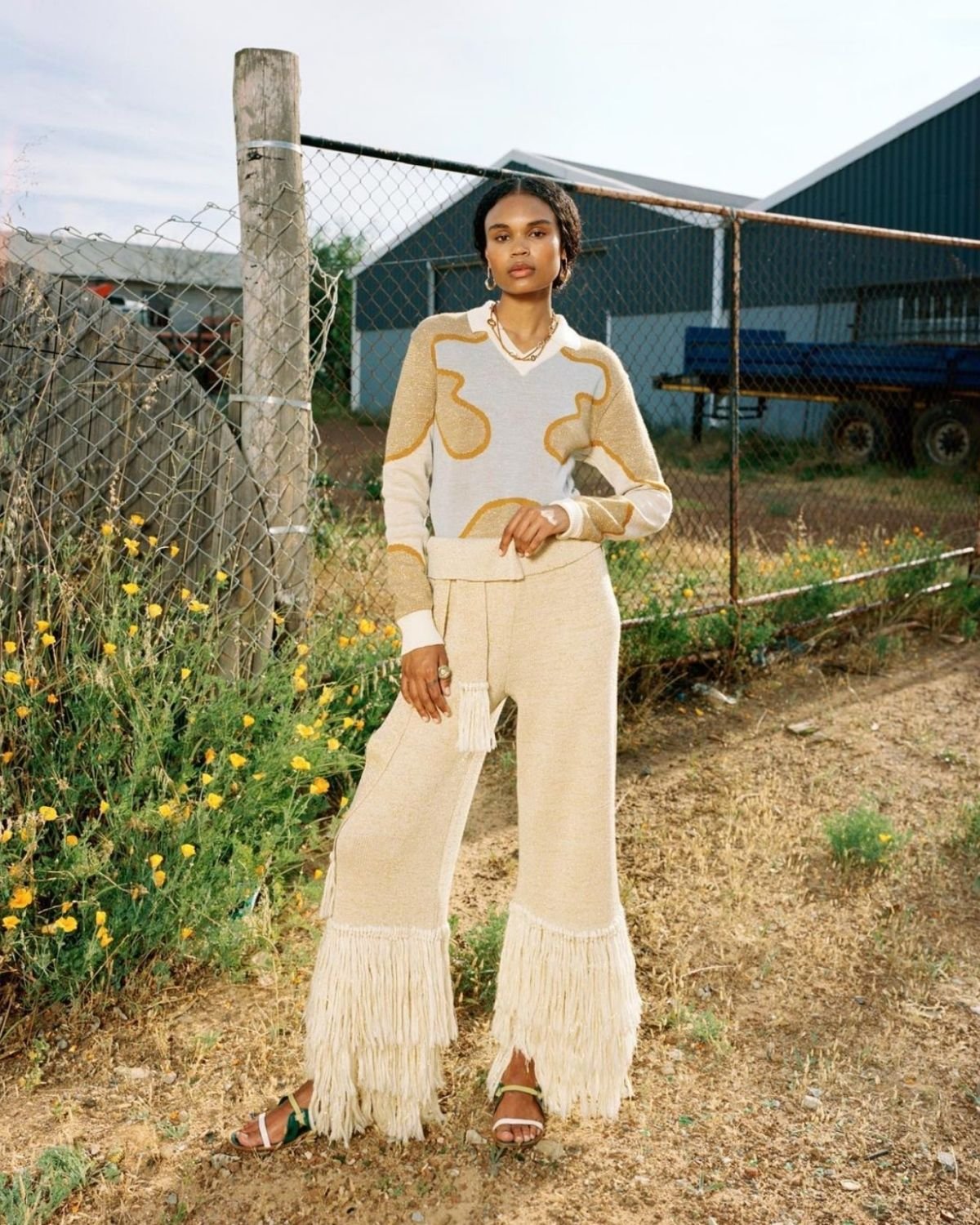Sustaining Neighborhood Cape Town Sustainable Fashion for a Greener Future
Sustaining Neighborhood Cape Town Sustainable Fashion for a Greener Future
Blog Article
Stay Ahead of the Curve by Checking Out Cutting-edge Style Trends
In a market as vibrant as fashion, staying ahead entails even more than just following current trends-- it demands an expedition of development. Smart fabrics, for example, are changing garments right into practical work of arts, while 3D printing is transforming style processes with its customizable, waste-reducing capacities. As sustainability ends up being a cornerstone, developments like environment-friendly materials and circular fashion techniques are reshaping environmental responsibility - Cape Town Sustainable Fashion. Furthermore, the merging of modern technology and style declares a brand-new age of customer interaction. How, after that, can these arising fads redefine the future of style, and what effects do they hold for brand names looking for to grow in this developing landscape?

Embracing Smart Textiles
Recently, the apparel industry has seen a transformative shift with the assimilation of smart fabrics, a cutting-edge innovation that blends technology with fabric. This advancement stands for not only a combination of looks and capability yet also a considerable jump in the direction of sustainability and personalization in vogue. Smart fabrics, also referred to as e-textiles, embed advanced electronic devices such as sensing units and conductive strings within the fabric, making it possible for garments to communicate with the environment or the wearer.
These textiles are designed to keep an eye on physiological criteria, such as heart price or body temperature, giving real-time health analytics. Past health applications, wise fabrics are also being utilized for flexible apparel, which can change shade or pattern in action to environmental stimuli, hence offering a vibrant style experience.
Moreover, the advancement of energy-harvesting fabrics that produce power from motion or sunlight is leading the way for self-dependent wearable innovation. This advancement is interesting ecologically mindful customers and developers aiming to lower the environmental footprint of style. As r & d in this area development, smart textiles are anticipated to become increasingly widespread, reshaping the landscape of contemporary fashion with their multifunctional capabilities.
The Increase of 3D Printing
Revolutionizing the production landscape, 3D printing has arised as a game-changer in the style industry. This advanced innovation has actually made it possible for developers to press the borders of creativity, generating intricate and tailored garments that were formerly unbelievable. By leveraging digital design and additive manufacturing, 3D printing assists in the creation of intricate geometries and patterns, permitting designers to experiment with new appearances and frameworks.
A noteworthy advantage of 3D printing in fashion is its capacity to produce on-demand, minimizing waste and lowering stock demands. This performance not only maximizes production procedures but additionally permits for quick prototyping, enabling developers to bring their visions to life in a much shorter duration. Moreover, 3D printing sustains customization somewhat unequaled by typical methods, providing customized fits and distinct styles tailored to individual consumer choices.
The surge of 3D printing has also equalized fashion, making it accessible to arising designers who can currently produce high-quality items without considerable monetary investment in conventional manufacturing framework. As technology remains to development, the fashion business is poised to harness the complete capacity of 3D printing, exploring brand-new materials and strategies that will definitely redefine just how style is conceived and produced.
Lasting Fashion Developments
As the garment industry faces the pushing requirement for environmental duty, sustainable style developments have arised at the forefront of transformative modification. The expanding awareness of environmental effect has actually fueled a shift in the direction of more eco-conscious techniques and materials. Developers and brand names are currently prioritizing sustainability, including approaches that decrease waste and reduce carbon footprints.
One considerable development is the increase of circular style, which emphasizes recycling and upcycling to extend the lifecycle of garments. This approach not only decreases waste however also motivates consumers to take on an extra mindful strategy to clothes intake.
One more advancement Discover More Here hinges on the adoption of innovative dyeing strategies that utilize all-natural dyes or waterless processes, thus lowering the large quantities of water and chemicals generally utilized in textile dyeing. In addition, developments in biotechnology have actually caused the production of lab-grown leather and fabrics, supplying cruelty-free and eco-friendly options to standard products. With these introducing initiatives, the garment industry is making meaningful strides towards a more lasting future.

Tech-Integrated Garments
Tech-integrated apparel represents a groundbreaking blend of fashion and technology, reshaping just how individuals interact with their clothing. This ingenious domain name is marked by the inclusion of wise fabrics and ingrained electronic components, enhancing both functionality and visual allure. From health and fitness trackers embedded in sportswear to heated jackets regulated via smart device applications, tech-integrated clothing provides consumers extraordinary comfort and versatility.
Introducing brand names are driving this pattern, concentrating on producing garments that react to environmental stimuli or individual commands. As an example, some garments can change shade or pattern in reaction to temperature changes, while others incorporate biometric sensing units to keep track of health and wellness metrics like heart price or stress and anxiety degrees. The smooth integration of innovation into fabrics additionally prolongs to see this here ecological sustainability, with initiatives to create self-cleaning fabrics or garments that readjust to weather conditions, hence lessening the requirement for multiple layers.
In addition, the advent of wearable innovation is not simply restricted to clothes however reaches devices like watches and eyewear, more expanding the range of tech-integrated fashion. As the market proceeds to innovate, the possibility for personalization and customization in clothing grows, providing customers one-of-a-kind, tech-enhanced style experiences that deal with their individual needs and preferences.
Future of Virtual Fashion
Recently, the future of online fashion has arised as a transformative force within the sector, leveraging advancements in digital modern technology to redefine how fashion is created, experienced, and eaten. By incorporating increased reality (AR), online fact (VIRTUAL REALITY), and 3D style tools, developers can currently craft interactive and immersive experiences that transcend conventional fashion borders. Digital fashion enables the development of garments that exist only in electronic environments, using countless opportunities for technology without the constraints of physical manufacturing.
This digital change not only provides opportunities for innovative expression but additionally addresses sustainability problems inherent in traditional fashion practices. Cape Town Sustainable Fashion. By getting rid of the need for physical resources, virtual fashion decreases waste and reduces carbon impacts. Moreover, the increase of online style lines up with the boosting consumer demand for customized and distinct experiences, as virtual garments can be customized and tailored to specific preferences easily

Conclusion
The style sector's future depend on the combination of sustainable techniques and cutting-edge technologies - Cape Town Sustainable Fashion. Smart fabrics and tech-integrated garments are improving performance, while 3D printing offers opportunities for customization and waste decrease. Sustainable fashion, via green products and round strategies, demonstrates a commitment to environmental stewardship. Furthermore, virtual fashion is positioned to redefine consumer interactions. Adapting to these fads read the full info here is essential for brand names looking for to continue to be relevant and affordable in this quickly evolving landscape.
In current years, the style sector has observed a transformative shift with the assimilation of clever fabrics, an advanced innovation that blends modern technology with fabric.As the fashion sector grapples with the pushing requirement for environmental responsibility, sustainable style innovations have actually emerged at the center of transformative adjustment.In recent years, the future of virtual style has actually arised as a transformative force within the sector, leveraging advancements in digital innovation to redefine just how fashion is developed, experienced, and eaten. The rise of online fashion lines up with the boosting customer need for tailored and unique experiences, as digital garments can be customized and customized to individual preferences with simplicity.
The fashion market's future lies in the combination of lasting methods and cutting-edge technologies.
Report this page